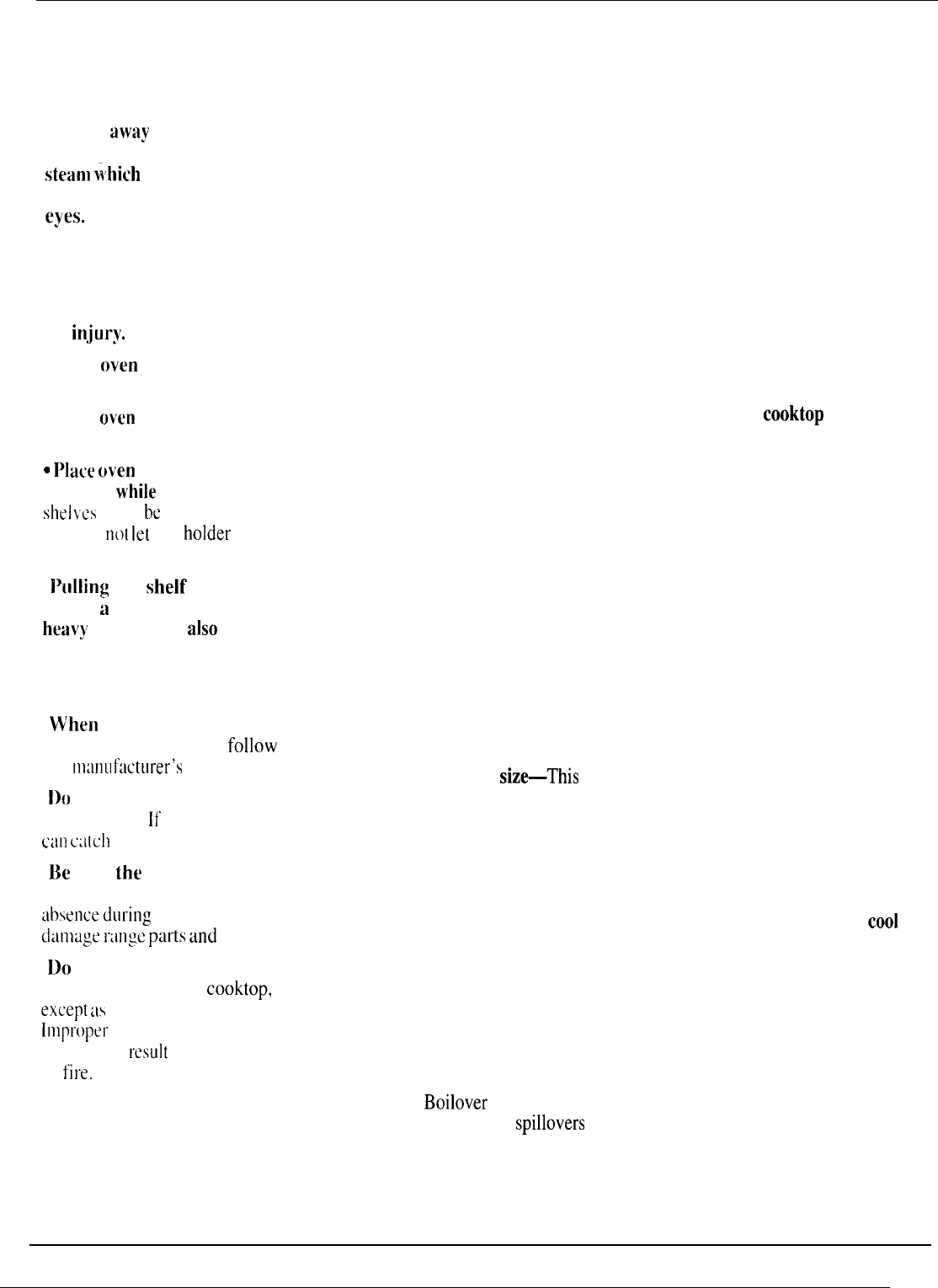
IMPORTANT SAFETY INSTRUCTIONS
(continued)
Oven
. Stand
away
from range when
opening oven door. Hot air or
steam
~hich
escapes can cause
burns to hands, face and/or
eyes.
●
Don’t heat unopened food
containers in the oven. Pressure
could build up and the
container could burst, causing
an
in(jury.
●
Keep
oven
vent duct
unobstructed.
●
Keep
oven
free from grease
buildup.
“
Place
oven
shelf in desired
position
while
oven is cool.
If
sbeltcs
must
be
handled when
hot, do
not
let
pot
holder
contact
heating units in the oven.
●
P~llling
out shelf to the shelf
stop is
a
convenience in lifting
heavy
foods. It is
also
a
precaution against burns from
touching hot surfaces of the
door or oven walls.
●
W’hen
using cooking or
roasting hags in oven,
follow
the
lll:lrlllf:ictLlrer’s
directions.
●
I)o
not use
your oven to dry
newspapers.
lf
overheated, they
can
c:i(ch
fire.
●
Be
sure
the
vent duct is not
covered and is in place.
Its
ahsence
during
cooking could
dan)tige
riinge
parts
and
wiring.
●
Do
not
use aluminum foil to
line oven bottom
or
cooktop,
except
as
suggested in manual.
lrnproper
installation of these
liners may
result
in electric shock
or
fire.
Self-Cleaning Oven
●
Do not clean door gasket
before reading special cleaning
instructions in the Self-Clean
section of this book.
The door
gasket is essential for a good
seal. Care should be taken not to
rub, damage or move the gasket.
●
Do not use oven cleaners. No
commercial oven cleaner or oven
liner protective coating of any
kind should be used in or around
any part of the oven,
●
Clean only parts listed in this
Use and Care Book.
●
Before self-cleaning the oven,
remove broiler pan and other
cookware.
●
Listen for fan—a fan noise
should be heard sometime during
the cleaning cycle. If not, call for
service before self-cleaning
again.
●
Be sure to wipe up excess
spillage before starting the
self-cleaning operation,
Surface Cooking Units
●
Use proper pan
siz+This
appliance is equipped with one or
more surface units of different
size. Select cookware having flat
bottoms large enough to cover
the surface unit heating element.
The use of undersized cookware
will expose a portion of the
heating element to direct contact
and may result in ignition of
clothing. Proper relationship of
cookware to burner will also
improve efficiency.
●
Never leave surface units
unattended at high heat
settings.
Boilover
causes
smoking and greasy
spillovers
that may catch on fire.
●
Be sure drip pans and vent
ducts are not covered and are
in place. Their absence
during
cooking could damage range
parts and wiring.
●
Don’t use aluminum foil to
line drip pans
or anywhere in
the oven except as described in
this book. Misuse could result in
a shock, fire hazard or damage to
the range.
.
Only certain types of glass,
glass/ceramic, earthenware or
other glazed containers are
suitable for
cooktop
service;
others may break because
of the
sudden change in temperature.
See section on Surface Cooking
for suggestions.
●
To minimize the possibility of
burns,
ignition of flammable
materials, and spillage, the
handle of a container should be
turned toward the center of the
range without extending over
nearby surface units.
●
Always turn surface unit to
OFF before removing
cookware.
●
Keep an eye on foods being
fried at HI or MEDIUM HI
heat settings.
●
To avoid the possibility of a
burn or electric shock, always
be certain that the controls for
all surface units are at OFF
position and all coils are
cool
before attempting to remove
the unit,
4


















